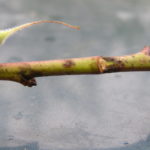By Katarzyna Madalinska and Anne Nielsen
New Jersey is currently in its 5th year of invasion from spotted lanternfly. Populations are now widespread throughout the state and have established in almost every county in NJ. SLF pressure is variable throughout NJ’s counties, and we do not currently have a threshold for management of nymphs.

1st instar SLF in NJ vineyard – photo by K. Madalinska
SLF nymphs are hatching throughout the state and will continue to do so in the coming weeks. Despite seeing nymphs within the vineyard, we do not recommend immediate treatment at this time. Hatch will occur over a multiple week period depending on the site of egg masses and exposure. The early instars feed on new growth, particularly the underside of leaves and shoots. At this point there is no evidence that early instar feeding results in plant injury or yield loss. Peak abundance of SLF nymphs in vineyards is during their 1st to 2nd instars approximately and 2-3 weeks after the first hatch. Management during their 2nd instar will target the highest number of individuals and prevent additional treatments against nymphs. This timing typically coincides with other key pests within the vineyard, such as grape berry moth and Japanese beetle. Many broad-spectrum insecticide options for grape berry moth or Japanese beetle will also effectively kill SLF nymphs (see table) and insecticides against SLF will not be needed until the adult stage.
| Trade name | Active ingredient | Class | Rate per acre | Seasonal Allowance | SLF* | GBM | JB |
| Brigade 2EC | bifenthrin | Pyrethroid | 3.2-6.4 oz | 6.4 oz | E* | E | |
| Actara | thiamethoxam | Neonicotinoid | 3.5 oz | 7.0 oz | E* | G | |
| Assail 30SG | acetamiprid | Neonicotinoid | 2.5-5.3 oz | 2 times | G | G | F |
| Carbaryl 4L | carbaryl | Carbamate | 1-2 qt | 10 qt | E | G | G |
| Avaunt | indoxicarb | Oxadiazine | 6 oz | 12 oz. | E* | G | G |
| Danitol 2.4EC | fenpropathrin | Pyrethroid | 16-21.33 oz | 42.66 oz | E* | E | E |
| Belay | clothianidin | Neonicotinoid | 2.0–6.0 oz. | 12 oz. | G | G | G |
| BaythroidXL | cyfluthrin | Pyrethroid | 1.6-3.2 oz | 12.8 oz | E | E |
Always consult the label for further instructions.
*2(ee) approved for SLF in NJ grapes
E = excellent control
G = good control
F = fair control

